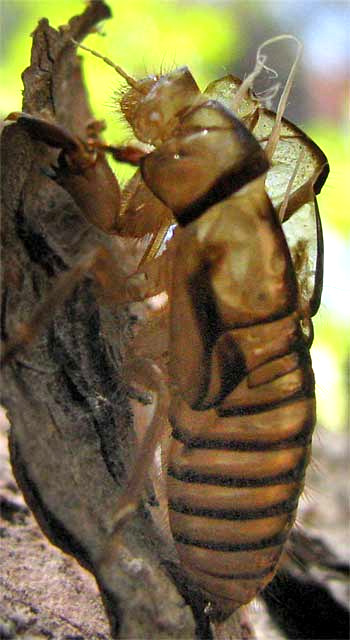Excerpts from Jim Conrad's
Naturalist Newsletter
from the July 12, 2009 Newsletter, issued from the Siskiyou Mountains west of Grants Pass, Oregon:
A CICADA EXUVIA'S TRACHEAL TUBES
Though the Orchard Cicadas we profiled earlier (online at http://www.backyardnature.net/n/a/o-cicada.htm) are seen from time to time, they're not common and I still haven't heard any calling. However, this week I did find a recently emerged larva's abandoned exoskeleton, or exuvia, which you can see below.

That picture is particularly interesting because it shows so clearly the white, threadlike things emerging from the exuvia's interior. There's a story behind those.
For, insects don't have anything like our lungs. They have holes in their abdomens and thoraxes that lead to tubes, or trachea, which carry oxygen into their bodies. Even though the tracheas are inside the insects' bodies, they are part of the exoskeleton, so, when the larva sheds, its trachea linings are shed as well. The threadlike things emerging from the exuvia are the trachea linings from inside the recently emerged cicada larva's body.
from the July 12, 2009 Newsletter, issued from near Natchez, Mississippi, USA
THE TROLL
This spring and summer we've experienced frequent showers, but our years-long, overall drought has continued. Brief showers have kept plants green but when in the gardens I dig 4 inches (10 cm) down I encounter pure dust.
Thus Tuesday when I spotted a freshly constructed 1.5-inch high (4 cm) little tower of wet mud along my bike trail across the very dry blackberry field, I knew I'd come upon a mystery. In such a parched, dusty field at the top of a rise with the water table surely many feet below the surface, where would fresh mud come from? And what could build such a mud tower?
On my knees and elbows I gingerly nudged the little mud turret and was surprised to find that it simply rested atop the hard-packed dust, unattached to anything. I lifted it. Below was a round tunnel entrance about 3/4-inch across (2 cm). As my eyes adjusted to the tunnel's darkness I saw that the tunnel bifurcated right below the entrance, and that at least one of the resulting arms quickly forked again. And from the blackness of one of those tunnel branches someone sat looking squarely back at me. The little being had wide-set eyes placed at the upper corners of a triangular face. On crabby legs it then stepped forward and began scooping dirt as I watched, as if its ceiling hadn't disappeared. Its body was thick, white, and it glistened with wetness. Working with a certain sense of urgency, it struck me as being like a troll in a Hobbit novel. If I had been exploring Mars and come upon a new form of life in a crater at the edge of a field of frozen carbon dioxide, I could not have been more filled with a sense of observing something otherworldly.
Gradually I realized that this was a cicada nymph -- the immature stage of the cicada that lives underground, often for years, before emerging to become the "Jar Fly" that so noisily makes buzz-saw sounds in the trees these days.
But, how did the nymph produce mud from such dry ground? Also, I have seen diagrams of cicada-nymph tunnels, and they have always been simple affairs, with no forks in them. I have combed the Internet looking for explanations, but without success.
My guess is that the nymph made its mud by mingling tree-root juice with dust, for what other explanation is possible?